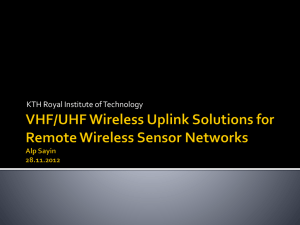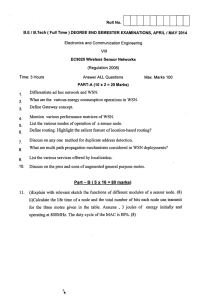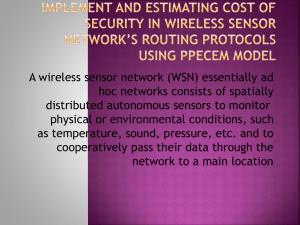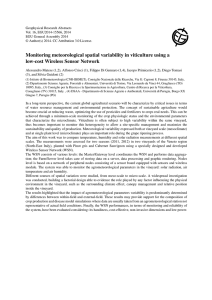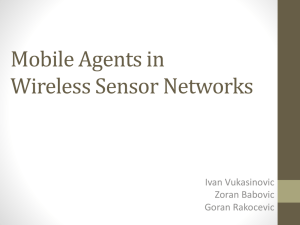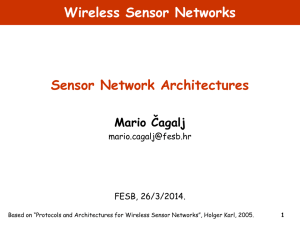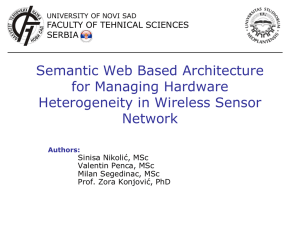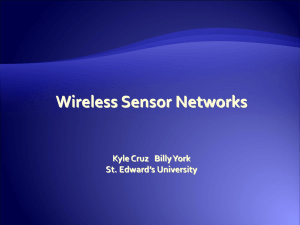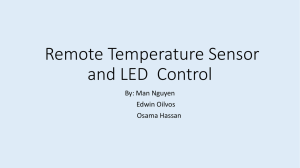Group_Order27
advertisement
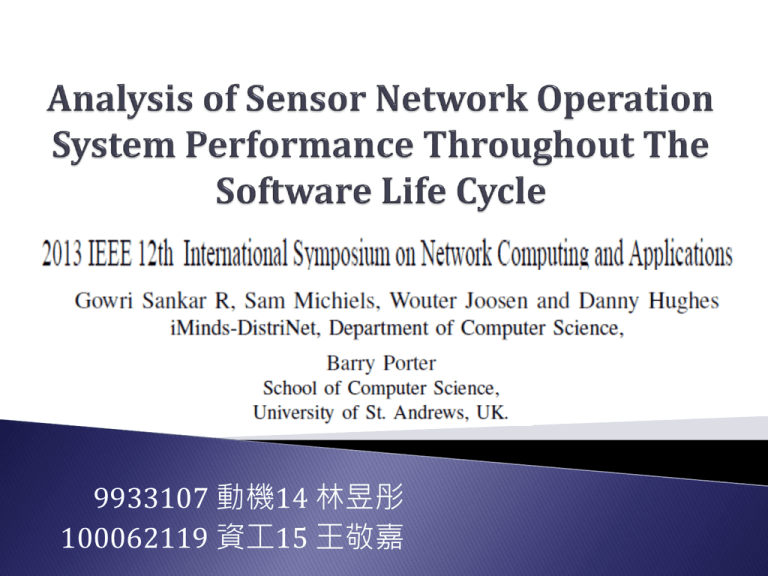
9933107 動機14 林昱彤 100062119 資工15 王敬嘉 Introduction Goal Fair Comparison • Hardware, OS selection Measurement • Application description, Measurement approach Result Discussion Conclusion 動機14 林昱彤 2/24 無線感測網路 • • A system consisting of a collective of networked sensor nodes designed to intercommunicate via wireless radio. sensor, processor, communication 1. 省電 2. 價格低廉 3. 體積小 網路 衛星 其他傳輸媒介 server 動機14 林昱彤 Wireless Data Collector WSN region 3/24 Application domains: ◦ 軍事、商業、醫藥、安全和生態學等 Challenge: ◦ resource-constrained nature of WSN hardware platforms ◦ dynamic operational environment 動機14 林昱彤 4/24 the performance of the WSN operating systems to make an informed choice when selecting an operating system for WSN developers software life cycle: 動機14 林昱彤 5/24 Tmote Sky is a TI MSP430-based hardware platform that provides a 16-bit microcontroller clocked at 8MHz running on a 3V power supply. TelosB has the hardware sensors for temperature, humidity and light. In addition, it has a CC2420 802.15.4 radio chip for communication with neighbouring nodes. 動機14 林昱彤 6/24 Three criteria of selecting: • actively maintained and supported • support test platform: the Tmote Sky • Provide support for remote reprogramming 動機14 林昱彤 7/24 Tiny OS Contiki OS Lorien OS 動機14 林昱彤 8/24 designed for networked embedded devices. Advantages: NesC : reduces the memory requirement consumes less resources Disadvantages: does not preserve component structure after compilation lack of available implementations version-2.1.2 used the built-in interfaces of TinyOS for sensing and radio communication 動機14 林昱彤 9/24 designed for use in WSN applications which require support for IP-based communication. Advantages: ◦ supports a wide range of hardware platforms ◦ works with modular upgrading methodology version-2.6 use the pre-defined methods of Contiki for sensing and radio communication 動機14 林昱彤 10/24 Architectural model similar to TinyOS preserves its component-structure throughout the software life cycle Advantages ◦ well suited for dynamic operating environments version-2.8.4 Use the built-in interfaces for sensing and radio communication 動機14 林昱彤 11/24 Use 6 example Applications From simple to complex ◦ Use Sensor or not ? ◦ Use Radio or not ? ◦ The functions are complicated or not ? 資工15 王敬嘉 12/24 Applications Sensor Radio Function Blink X X • Toggle LED once/ per sec Sense O X • Sample SHT11 sensor once/per sec • Blink LED Blink-Remote (BlinkRx) X O • Toggle LED when receive message via CC2420 radio Sense-Remote (BlinkTx) O O • Sample sensor once/per sec • Transmit sensor reading using radio Aggregate O O • Receive messages from radio • Buffer message • Transmit to gateway when buffer full Encryption (XTEA) O O • Receive messages from radio • Encrypts message by XTEA algorithm 資工15 王敬嘉 13/24 Development -> counting LOC Use OS-specific software tool Calculate each application 10 times <- Power Consumption 資工15 王敬嘉 14/24 By counting the LOC (Lines of Code) Tiny OS & Lorien : 70 lines avg/each app Contiki : 39 lines avg/each app Contiki is best in rapid prototyping ! 資工15 王敬嘉 15/24 In flash ROM Converge! Tiny OS win! 資工15 王敬嘉 16/24 In RAM Lorien : overhead of compomentization Contiki : need Build-time optimisation Tiny OS the best ! 資工15 王敬嘉 17/24 Contiki : consumes more energy Aggregate : sampleOS sensor 5 times then transmit; use !more radio 資工15 王敬嘉 18/24 Size of the binary artefact to be transmitted Tiny OS : need entire app to be transmitted poor in dynamic scenarios 資工15 王敬嘉 19/24 Software reconfiguration : 2 steps ◦ App artefact be injected into hardware platform ◦ Hardware platform restart or new app artefact integrated with OS runtime Tiny OS : 2 commands Contiki : 2 commands Lorien : 7 commands average Lorien is much complex 資工15 王敬嘉 20/24 Contiki OS Development _ LOC Tiny OS - Execution _ Memory : RAM - Execution _ Memory : ROM Tiny OS >> Converge Execution _ Energy - - Reconfiguration _ artefact size - 資工15 王敬嘉 Lorien OS - 21/24 Bad (*) Average(**) Good(***) Tiny OS : for simple and static apps 資工15 王敬嘉 22/24 WSN apps remain as a challenge ◦ Resource-constrained hardware platform ◦ Dynamically changing application environment Help WSN developers to select OS for WSN apps Future Work ◦ Explore dynamic optimisation of WSN OS ◦ Design their own OS that combines all the benefits 資工15 王敬嘉 23/24 Thank YOU ! 24/24
